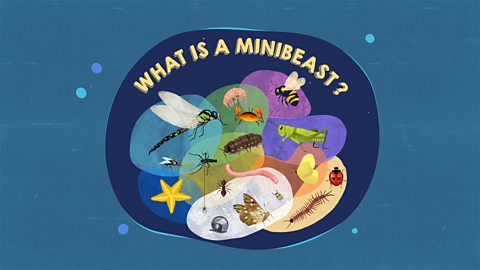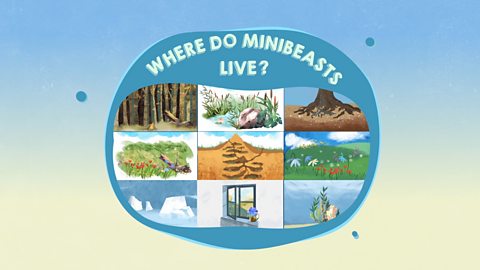Child VO:Do minibeasts have have super-powers?
Maddie Moate:Hello! Who likes superheroes?
Children:We do!
Maddie Moate:Did you know that some minibeasts have super-powers?
Maisie:No way! Like what?
Maddie Moate:Lots of minibeasts can fly, or breathe underwater, or run reallyfast, but some minibeasts have special powers that help them todo a job, or defend themselves, or help them get food. Can youthink of any examples of minibeasts that do a job that helps us?
Connie:Bees make honey that we eat.
Maddie Moate:That's right! Bees can collect flower nectar from plants and storethe sugars inside the honeycomb of their hives. Here, they turn itinto honey, and when it's ready, beekeepers can harvest some toeat. Yum! As the bees are going from plant to plant collecting thenectar they are also doing another really important job -spreading the plant's pollen, and this helps new plants to grow.This is why bees are a vital part of our ecosystem. Can you thinkof any other minibeasts that help us?
Child VO:What about worms? They help the soil.
Maddie Moate:Yes, earthworms help to aerate the soil. This means they loosen,mix and add oxygen to the soil as they move through it. Thismakes the soil better for growing plants, so farmers andgardeners like to have lots of earthworms in their soil. Someminibeasts have superpowers to help protect themselves. Tounderstand why minibeasts need to protect themselves, it helpsto look at where they sit in the food chain. A food chain describesthe order of living things and how they depend on each other forfood. Minibeasts are often low on the food chain. Because theyare small, many bigger animals look at them as food. This meanslots of minibeasts use their super-powers to protect themselvesfrom predators. For example, Hawthorn Shieldbugs live here inthe UK and mostly eat hawthorn berries. But birds want to eatthe shieldbugs so they defend themselves by spraying a smellyliquid. It puts off the hungry predators. This is why they are alsosometimes called stinkbugs. What other super-powers canminibeasts use to defend themselves?
Maisie:This jungle nymph comes from the tropical rainforests ofSoutheast Asia and uses its camouflage to turn nearly invisible!
Connie:It looks just like a leaf!
Maddie Moate:Jungle nymphs are a type of stick insect, which all use theircamouflage appearance to blend in with their jungle habitats.This helps them to avoid predators. Some minibeasts use theirsuper-powers for hunting and for protection, like this Asian forestscorpion. Its natural habitat is the tropical rainforests ofSoutheast Asia. He has a venomous stinger in his tail, which canbe used to hunt and to fend off predators such as owls or bats.
Jack:Cool, so they use their superpower to defend themselves frombigger animals!
Maddie Moate:Exactly! Even some of the smallest minibeasts have surprisingsuper-powers, like these ants. Ants have super strength; a singleant can carry 50 times its own bodyweight, and they can work asa group to move even bigger objects! This dung beetle is theworld's strongest animal by size! It can push over one thousandtimes its own weight, which is the equivalent to a human pullingsix double decker buses! Let's hear from our expert about hisfavourite minibeast and its superpower!
Yussef:Hi, I'm Yussef and I'm a minibeast expert. And I want to tell youabout a minibeast that has a very special superpower: the glowworm.Glow-worms are not actually a type of worm at all, they'rea type of beetle. And they come out at night when it's dark so itcan be quite tricky for them to find each other. Luckily, thefemales have a very special superpower that helps them with thisproblem: they can make their bottoms light up, a bit like a torch.They have a special chemical inside their bottoms and when itmixes with the oxygen in the air it creates this miraculous greenglow that makes them easier to spot. The scientific name for thisis bioluminescence, and it's just one of the many superpowersthat minibeasts have.
Maddie Moate:Minibeasts have all kinds of of super-powers, but sometimes theyneed our help to survive. Do you have any ideas of how you mighthelp minibeasts in your local environment?
Maisie:We're putting out a bug hotel so the minibeasts have somewheresafe to live.
Maddie Moate:Clever! Minibeasts will love crawling into all those little spaces.
Jack:Or we can let an area of garden grow wild!
Maddie Moate:Even a small wild area of garden at your home or your school,could attract lots of minibeasts. By adding piles of leaves, orstones, you can provide a habitat for minibeasts, allowing themmake the most of their superpowers!
Video summary
In this video, a group of children delve into the fascinating world of minibeasts and their ‘superpowers’.
They discover how minibeasts use their extraordinary abilities for various purposes, from helping humans to defending themselves against predators.
Expert insights and engaging demonstrations highlight the diversity of minibeast superpowers and their significance in ecosystems.
Teacher notes
Discussion points:
1. Introduction to minibeast superpowers:
- Discuss the concept of superheroes and superpowers. Ask – ‘If you had a superpower what would it be and why?’.
- Introduce the idea that minibeasts possess extraordinary abilities that help them survive and thrive in their habitats and we can call these ‘superpowers.’
- Ask – ‘Why are minibeast superpowers important for their survival in their habitats?’
2. Minibeast defence mechanisms:
- Investigate the different defence mechanisms used by minibeasts to protect themselves from predators, such as camouflage, chemical defences, and venomous stingers. Ask the children to name some specific examples.
- Explore how these adaptations help minibeasts survive in their environments.
3. Minibeast hunting abilities:
- Examine how certain minibeasts use their ‘superpowers’ for hunting prey, including venomous stingers in scorpions and formidable strength in ants and dung beetles.
- Discuss the role of these hunting abilities in the minibeast food chain, asking pupils for examples of how minibeasts with these abilities capture their prey.
4. Minibeasts helping humans:
- Explore examples of minibeasts that perform valuable tasks beneficial to humans, such as pollination by bees and soil aeration by earthworms.
- Discuss the importance of these minibeast contributions to ecosystems and to the wellbeing of humans.
Suggested activities:
1. Minibeast superpower showcase:
- Encourage children to research and create presentations or posters showcasing different minibeast superpowers and their significance.
- Provide resources for children to explore various adaptations, defence mechanisms, and hunting abilities.
- You could create ‘Minibeast Top Trumps’ as a variation of this activity.
2. Minibeast habitat enhancement:
- Guide children in designing and building bug hotels or wild garden areas to provide habitats for local minibeasts.
- Discuss the importance of creating suitable environments for minibeasts to thrive.
3. Invertebrate stories:
- Invite children to write creative stories or narratives featuring minibeast characters and their adventures in their habitats.
- Encourage children to incorporate scientific facts about minibeasts and their superpowers into their stories.
4. Minibeast observation and documentation:
- Organise outdoor excursions for children to observe minibeasts in their natural habitats.
- Provide journals or observation sheets for children to record their findings and document minibeast behaviours and adaptations.
5. Cross-curricular integration:
- Science and literacy: Children can create informative posters or brochures about minibeast superpowers, integrating scientific knowledge with literacy skills.
- Art and design: Encourage children to illustrate their stories or create artwork depicting minibeasts and their habitats, fostering creativity and artistic expression.
Curriculum Notes:
This video supports learning objectives related to science in KS1 within the national curriculums of England and Northern Ireland, and 1st Level in Scotland.
What is a minibeast? video
Learn about the diverse characteristics and habitats of small invertebrates, from slimy snails to speedy spiders.

Where do minibeasts live? video
Children learn about the diverse habitats that support minibeast communities around the world.
